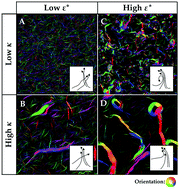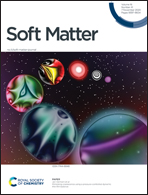Collective motion of driven semiflexible filaments tuned by soft repulsion and stiffness†
Abstract
In active matter systems, self-propelled particles can self-organize to undergo collective motion, leading to persistent dynamical behavior out of equilibrium. In cells, cytoskeletal filaments and motor proteins form complex structures important for cell mechanics, motility, and division. Collective dynamics of cytoskeletal systems can be reconstituted using filament gliding experiments, in which cytoskeletal filaments are propelled by surface-bound motor proteins. These experiments have observed diverse dynamical states, including flocks, polar streams, swirling vortices, and single-filament spirals. Recent experiments with microtubules and kinesin motor proteins found that the collective behavior of gliding filaments can be tuned by altering the concentration of the crowding macromolecule methylcellulose in solution. Increasing the methylcellulose concentration reduced filament crossing, promoted alignment, and led to a transition from active, isotropically oriented filaments to locally aligned polar streams. This emergence of collective motion is typically explained as an increase in alignment interactions by Vicsek-type models of active polar particles. However, it is not yet understood how steric interactions and bending stiffness modify the collective behavior of active semiflexible filaments. Here we use simulations of driven filaments with tunable soft repulsion and rigidity in order to better understand how the interplay between filament flexibility and steric effects can lead to different active dynamic states. We find that increasing filament stiffness decreases the probability of filament alignment, yet increases collective motion and long-range order, in contrast to the assumptions of a Vicsek-type model. We identify swirling flocks, polar streams, buckling bands, and spirals, and describe the physics that govern transitions between these states. In addition to repulsion and driving, tuning filament stiffness can promote collective behavior, and controls the transition between active isotropic filaments, locally aligned flocks, and polar streams.



 Please wait while we load your content...
Please wait while we load your content...